

Yak-1

The Yak-1 was judged to be the most promising competitor from a number of design bureau's that submitted designs for a new single seat fighter requested by the Soviet government in 1938. Its closest competitor was the LaGG-1 and was similar in design in that it was a low wing cantilever monoplane with a fully retractable undercarriage and powered by a twelve cylinder liquid cooled engine.
The prototype was flown for the first time in March of 1939 and soon proved to have much better performance and superior flying characteristics than the LaGG-1 which flew for the first time at the end of March. At this time the Soviet Union was short of light metal alloys for aircraft construction necessitating the extensive use of wood and welded steel tube. The one piece, two spar wing was built entirely of wood with a plywood skin and the fuselage was welded steel tube the forward position of which was covered by detachable metal panels and the aft section by plywood and doped fabric.
Its armament consisted of one 20 mm cannon and two 7.65 mm machine guns in the upper decking of the forward fuselage. Six RS-82 rockets could be carried beneath the wings and later some Yak-1's were fitted with under wing racks for two 110 lb. or 220 lb. bombs. From the outset Yakovlev adopted a policy of progressively refining one design and adapting it to undertake a variety of tasks, rather than evolving new designs that would have disrupted output while factories retooled. All Yakovlev fighters had three things in common; excellent stability under all flying conditions, good control ability at high angles of attack and extremely pleasant handling characteristics. By contemporary standards they lacked firepower and their altitude performance was poor but they were easily maintained under the most trying of conditions provided by the Eastern Front, operating in circumstances that would have grounded their more refined western contemporaries.
The Kit
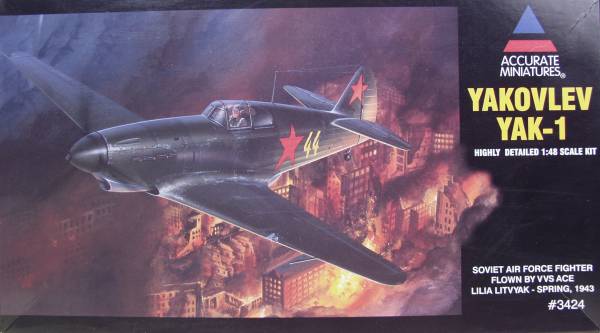
The Accurate Miniatures kit comes packaged like most of their kits in a two part box with a partition in the bottom which contains and protects the clear parts and decals. The kit is molded in a dark gray plastic with crisp recessed detail where appropriate. Since the wing was mostly wood there are not any panel lines. To me the fabric detail on the fuselage and control surfaces is a little over done but may look all right once painted. Most of the parts are relatively flash free with only minor parting lines that will need to be cleaned up. There are a few ejector pin marks but most won't show when assembled.
The cockpit side walls have overlays for the tube structure with nicely molded detail and is very well detailed. Belts and a harness are supplied on the decal sheet.The upper wing halves have structure detail molded in where it will be seen through the wheel wells. The landing gear doors have detail molded on both sides and the wheels are supplied both weighted and non-weighted and have tire data molded into the sides that requires a magnifier to read. The wheels have separate hubs making painting easy. The wing has a spar to make setting the dihedral easy and the flaps have internal detail so that if desired they can be cut out and displayed in a lowered position. Included is a template on the instruction sheet for a piece of styrene to block off the forward portion of the wing if one decides to lower the flaps.
The kit supplies two drop tanks and six rockets that can be added if desired. The clear pieces are reasonably transparent and include alternative rear portions for early and later versions. The canopy can be displayed open or closed. Other clear parts include wing tip and tail navigation lights, wing fuel gauge lenses, landing light, gun site and instrument panel to which decals are applied for the instruments. In spite of the extra protection provided by the packaging the movable portion of the canopy in my kit had what appeared to be a scratch on the inside which I suspect was a manufacturing defect. It should mostly disappear with a coat of Future or at least I hope it will. All totaled there are four sprues of gray plastic with 83 parts and two sprues of clear plastic with 16 parts for a total of 99 parts, not bad for a single engine fighter. Photos of the sprues are shown below.
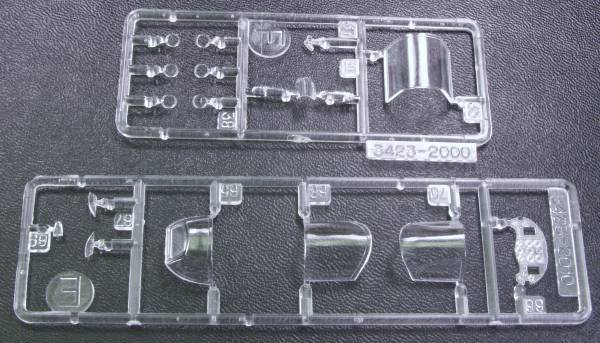
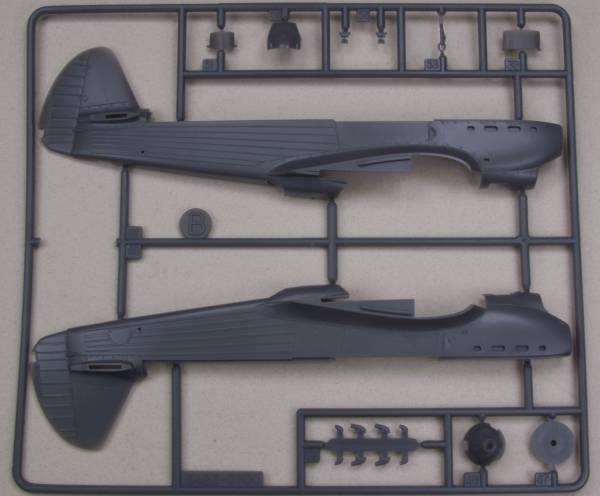
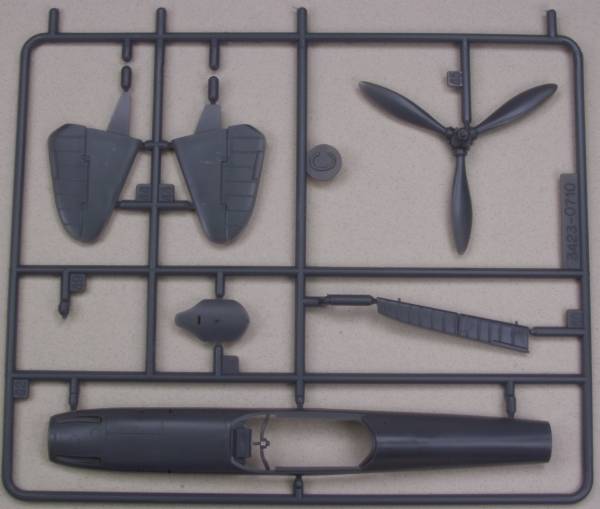
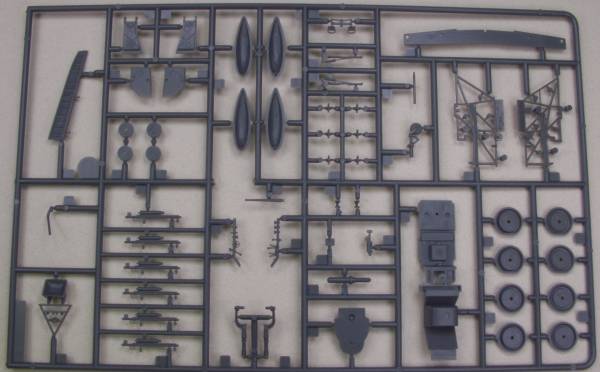
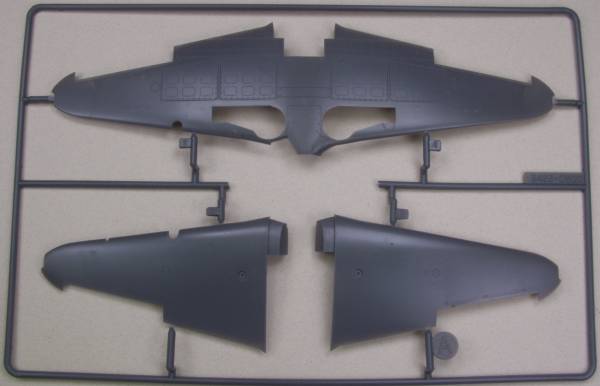
The decals look thin and well registered but do have some clear film surrounding them. they also appear to be a bit translucent. Markings for only one aircraft is supplied those being for the aircraft flown by female ace Lilia Litvyak at the time of the Battle of Stalingrad and represents a standard late production Yak-1. Lilia was credited with at least 12 enemy aircraft and was killed in action in 1943 at the age of 21. In addition to the national markings the sheet includes some stencil markings, the control panel instruments and the seat belt and harness. The sheet is shown below.
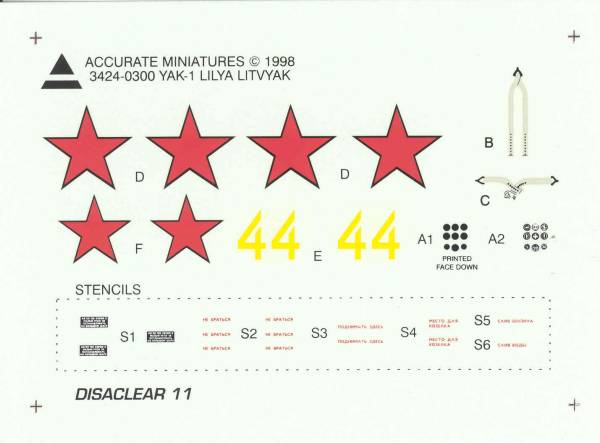
The instructions are printed on three 11" x 13" pages that are folded and stapled booklet style creating 12 pages. They include a brief history, very thorough painting information including a chart with the numbers for six different paint brands plus Federal Standard numbers, very thorough assembly instructions and a page showing decal placement and finishing information.
Conclusions
All in all this looks to be a very nice kit and most information I have found indicate it goes together well with only a few fit problems, most notably the upper fuselage deck which apparently is slightly narrow. The cockpit is amply detailed and only those with AMS will want to add anything to it.
Links to kit build or reviews
Review / builds can be found here and here
References
Famous Fighters of the Second World War by William Green
A good online resource for information on Soviet aircraft from 1917 through 1950 can be found here.
Back to the Russians are Coming
Updated 5/11/08